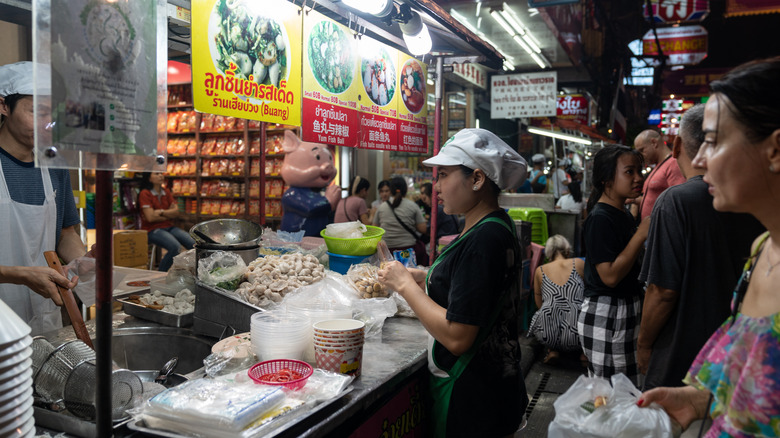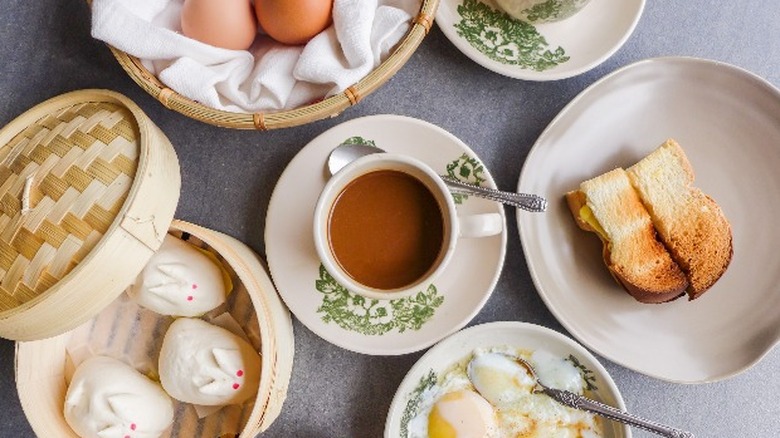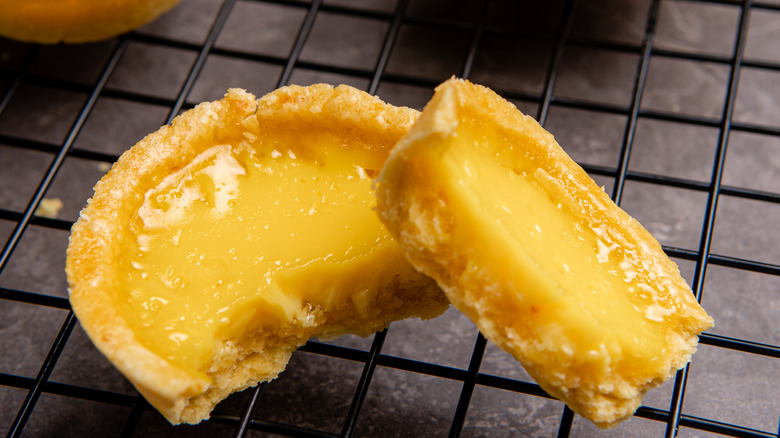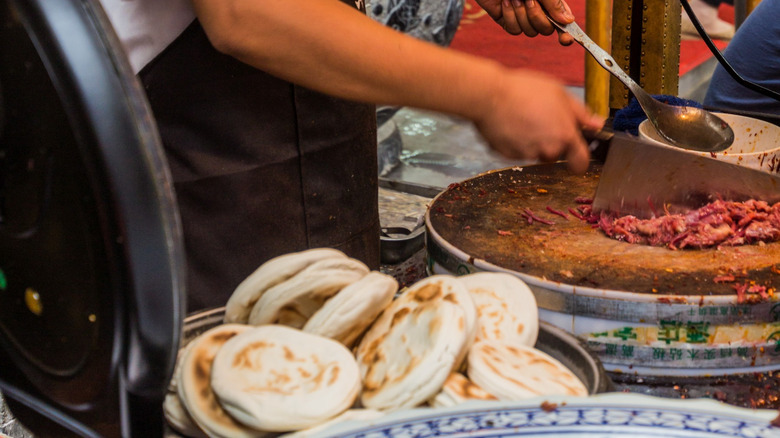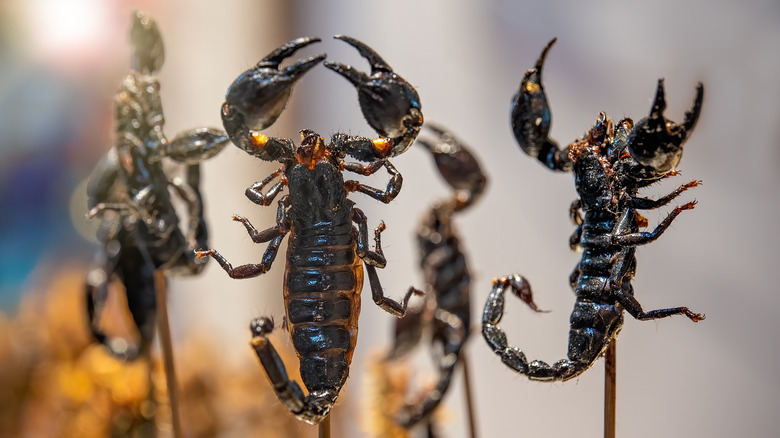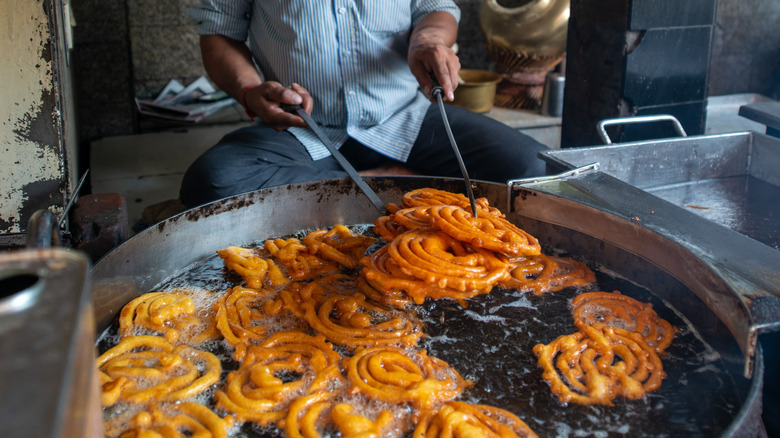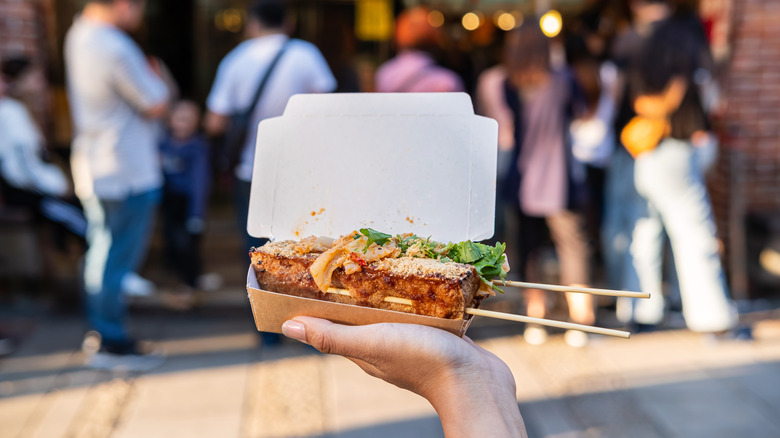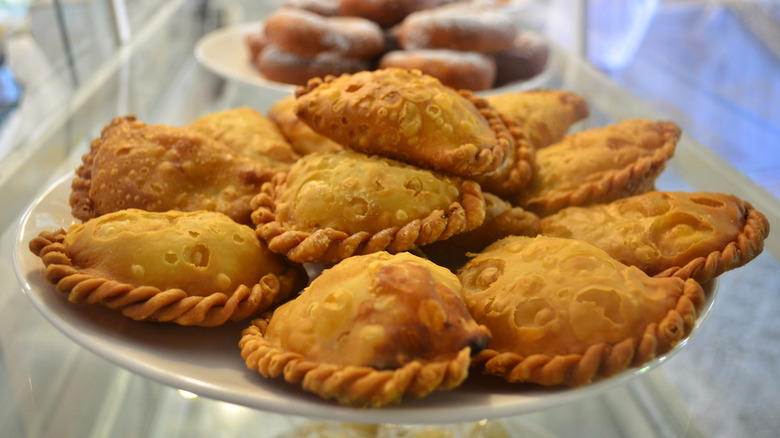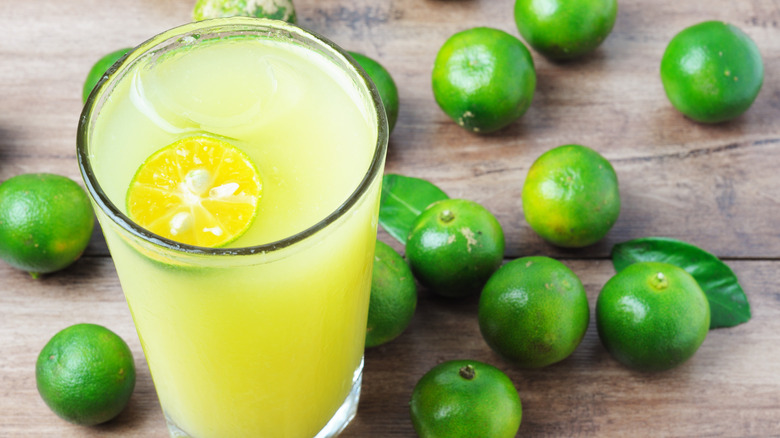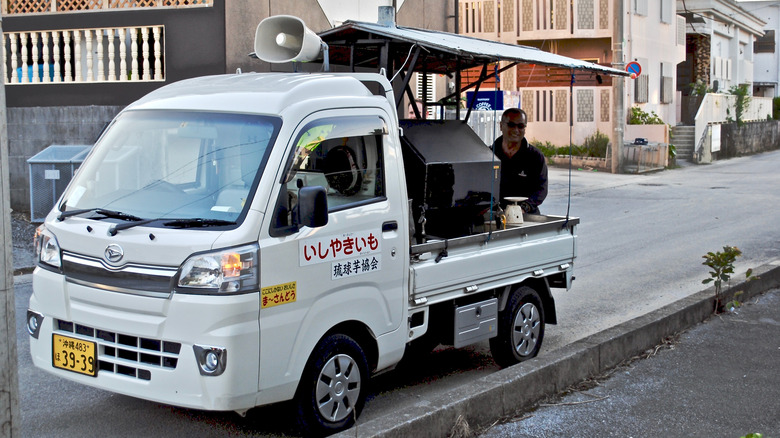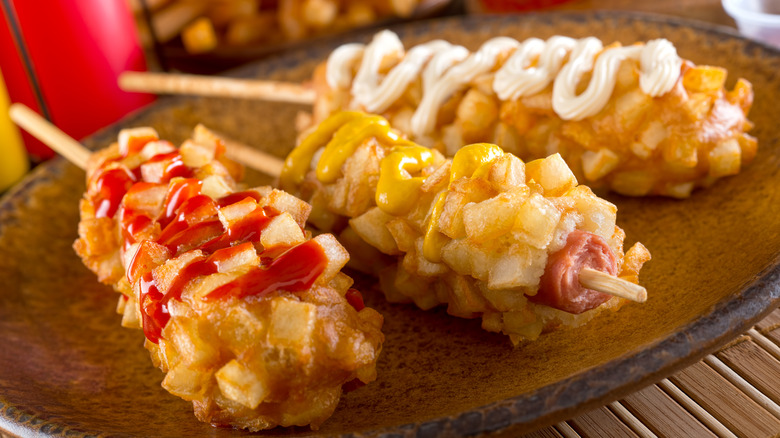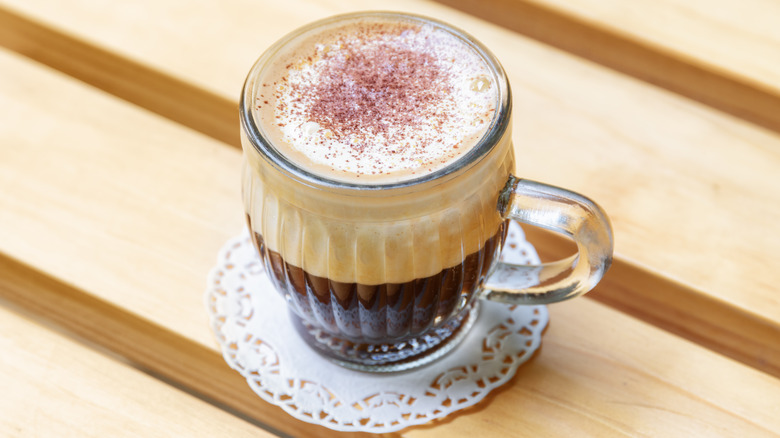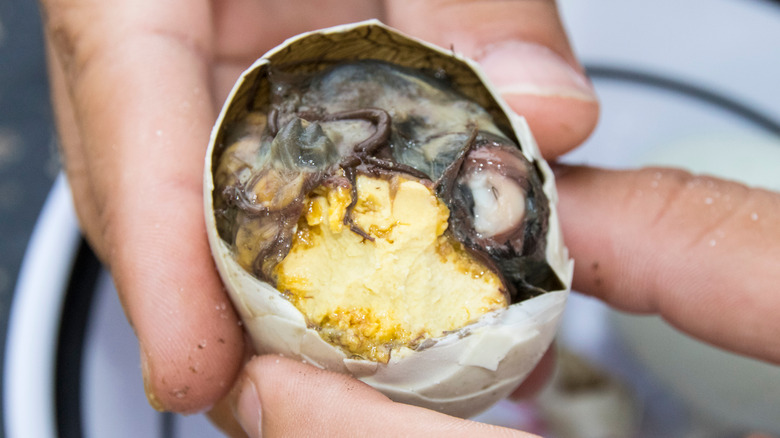Iconic Street Foods You Can Only Find In Asia
It's not unlikely that the most memorable part of a trip to any foreign country will be the street foods you eat there. To be certain, food enjoyed in a fine restaurant or even a friend's home can be excellent, but there's some special about food eaten on the go. Street foods exist to feed hungry local people as they go about their day, and the types of food that become known from a particular country can be seen as a microcosm of the regional ingredients, cooking techniques, culture, and lifestyle of that country. If you want to take a nation's culinary pulse, you can certainly do well by taking a bite of something from a stall or food truck.
To eat a street food is to sample a bite of that country's history in edible form. This is no more true than in Asia, where thousands of years of immigration, trade, innovation, and cultivation have given way to some of the most iconic street foods in the world. Our increasingly globalized world means you can get most things anywhere, but some foods and dishes can only be eaten in their home country due to various factors. So what iconic street foods of Asia can you only get by venturing abroad? Read on to find out.
Kaya toast - Singapore
One of the most popular and widely known dishes of the tiny yet fabulously wealthy nation of Singapore is known as kaya toast. Kaya is a type of smooth jam made from coconut and eggs, and when spread on toasted white bread it becomes kaya toast (via Culturally Experiences).
This breakfast dish is a perfect symbol of the mix of culture and history present in the country of Singapore. The thick slice of toasted white bread recalls the history of British occupation in the area, but instead of a marmalade or berry jam that you might find in Europe, the people of the region used what they had and made a jam from local coconut. They also sometimes employed caramelized palm sugar or aromatic pandan leaf. You can find this breakfast staple at local kopi (coffee) shops around Singapore, as The Straits Times reports. Order the full Singaporean breakfast to enjoy kaya toast with butter, strong robusta coffee, and soft-boiled eggs with soy sauce.
Egg tarts - Hong Kong
Not unlike kaya toast, Hong Kong egg tarts represent the mix of food and culture that has become emblematic of the major port cities of Asia. The origin of the egg or custard tart can date back to 13th century France, where it eventuallly made its way to nearby Portugal and then was brought to China by explorers, as per The Culture Trip.
Its popularity in Hong Kong grew in the '40s, when Chinese tea ceremonies and English afternoon tea culture blended. Egg tarts or, as they are known in Cantonese, daan tat, were adapted to account for local tastes and ingredient availability and quickly became a common fixture at tea time (via Pearl River Mart). Served in cha chaan tengs, or tea restaurants, Whetstone reports, these diners helped served these tarts to the masses. Now, you can find daan tat everywhere from street carts to refined afternoon tea ceremonies in just about every corner of Hong Kong.
Rou jia mo - China
Deep in the northern, mountainous region of China is a province called Shaanxi, legendary for the famous terracotta warriors uncovered in what may or may not be an emperor's cursed tomb. An extremely popular street food of this region is rou jia mo. Sometimes referred to as the Chinese hamburger (even though Eater reports that it predates the western hamburger), this dish could also be considered similar to the American sloppy Joe.
The literal translation means "meat in a bun" and consists of shredded pork belly mixed with a spiced, soy-based sauce stuffed into a yeasted, flour-based bun (via China Sichuan Food). The bun is made similarly to a scallion pancake and the dough is assembled in a long strip, rolled into a cylinder, and then rolled again into a flat disk again before being cooked in a hot cast iron pan. After cooking, the bun is split to create a pocket into which a mixture of meat is stuffed. Like all great street foods, this dish is perfect for eating on the go.
Fried scorpion - Thailand
While fried scorpions are not necessarily a popular food for local Thai people, this arachnid is undoubtedly an iconic street food to most Western tourists who visit this nation. The shiny black exterior of the scorpion's abdomen and its long, pointed pincers stick out from bamboo skewers up and down crowded tourist thoroughfares all across Thailand.
You can often find a variety of fried insects to sample, from grasshoppers to crickets, as Thaist notes, but the unique nature of the fried black scorpion is seared indelibly in the memory of any visitor long after their trip is over. While you can find versions of almost every Thai street food in cities across America, the truth is that you would be hard-pressed to find a fried scorpion. Adventurous eaters describe the taste as similar to burnt popcorn with a distinctive crunchy texture. Be careful to make sure that the poisonous stinger at the tip of the tail has been removed before sampling one yourself.
Jalebi - India
The coiled, crispy, orange rings of Indian jalebi make for one of the most visually stunning and memorable snacks found across India. The origin of the food has roots in 10th century Persia, as NDTV Food notes, where it eventually made its way to India by way of trade and travel. Even within India, there are cultural variations across the country. At its most basic, jalebi is a flour-based batter that's fried in a circular shape and then soaked in a sweet syrup. Variations include differences in the flavor of the sweetened syrup or the shape of the coils as the batter touches the hot oil or the even composition of the batter (via The Better India).
Some regions ferment the batter slightly overnight or add other ingredients, such as yogurt, to give it a tangy flavor. The sweetened syrup often contains saffron, which gives the jalebi its iconic orange coloring. While the method used to create this treat is similar to what's necessary to produce American funnel cake, there's no replacing the specific flavor and look of jalebi. Because they are fried hot and fresh to order, jalebi doesn't travel well so you'll have to book a ticket to India to try some for yourself.
Stinky tofu - Taiwan
Stinky tofu, or chou dou fu in Chinese, is a type of fermented tofu with an extremely pungent smell. Because the flavor of stinky tofu is an acquired taste (and smell) preferred by those who have become accustomed to it, this dish can be hard to find stateside. Travel to Taiwan, however, and you will find stands lining the streets serving up hot and crispy stinky tofu covered in garlic, soy, and chili sauces (via Atlas Obscura).
Like many happy accidents of the culinary world, this dish was invented when someone got the inventory wrong. As the story goes, a man named Wang Zhi He had an abundance of tofu that he placed in a jar to keep. According to Haaretz, after several days, it had fermented and soured. While it smelled bad, much to his surprise, the taste was delicious and so he began selling it to customers.
In modern times, this dish is created using careful procedures to prevent foodborne illness. In America, it can be difficult to find this product in stores due to food safety laws, and some people resort to making it at home with varying degrees of success, as the CDC notes. You're better off traveling to Taiwan and trying stinky tofu straight from the pros.
Khuushuur - Mongolia
Intrepid travelers may find themselves drawn to the beautiful, mountainous, land-locked country of Mongolia. Popular street foods of Mongolia are not well known in the United States, but anyone who has traveled there will be unlikely to forget the unique and memorable offerings. Khuushuur is a handheld type of meat or vegetable pastry widely available on the streets of Mongolia.
While similar meat-filled pocket pastries exist around the world, khuushuur is iconic in Mongolia for its unique flavors that come from local ingredients. The mountainous terrain is perfect for raising sheep, so lamb or mutton is the most common type of khuushuur filling, often seasoned with a mix of spices from surrounding areas. These spices can include coriander and Sichuan pepper from the east, saffron and sumac from the southwest, and caraway and fennel from the west. Like most street foods, The Guardian reports that it's meant to be eaten hot and on the go with paper napkins and sometimes a side of ketchup or Maggi sauce.
Calamansi juice - The Philippines
On a hot, sticky, humid day in the Philippines, locals and tourists alike cool themselves down with an ice-cold glass of sweetened calamansi juice. The calamansi is a citrus variety that lands somewhere between a mandarin orange and a lime, and the juice produced by the fruit is similar to lemonade or limeade, but much more flavorful and tart (via The Little Epicurean). According to Texas A&M, the calamansi is native to Southeast Asia and can be found in plentiful quantities at just about any grocer or fruit stand in the Philippines.
Because this particular variety of citrus can be hard to find in the US, fresh-squeezed calamansi juice is almost impossible to get stateside. Canned versions are imported, but some of the best nuances in flavor are lost in these preserved beverages. Travel to the Philippines, however, and you'll hardly pass a street corner without being tempted to buy a refreshing glass of calamansi juice. Filipinos also use the calamansi fruit to marinate fish, pork, and other savory dishes.
Yay kyaw bain mont - Myanmar
Wander the streets of Myanmar on any given morning and you are likely to find carts and stalls offering bain mont, a chewy, fluffy sort of pancake topped with things like nuts or seeds, as per the Myanmar Times. Some are offered with white poppy seeds, almonds, banana, coconut, or egg. Vendors cut up slices and serve them to-go for busy locals. Bain mont, or sometimes bein mont, translates literally to "poppy cake."
Two kinds of this street pancake can be found in Myanmar, a white and a brown. Both contain rice flour as a base, but the brown is mixed with palm sugar to add sweetness. The delicate batter crisps up to a perfectly brown pancake that needs no syrup or butter topping, unlike American pancakes. To achieve the fluffy consistency, the batter is either fermented or yeast is added (via Cheers Kitchen). Instead of rice flour, some recipes can even call for cooked, cold, leftover rice blended up with banana to create the batter.
Yaki imo - Japan
On cold winter days on the streets of rural and urban Japan, small trucks meander the streets loaded with hot baked sweet potatoes. Now, These are not like American baked potatoes- the varieties of sweet potatoes used for this dish have natural sugar and creaminess that's brought out by cooking them a long time over a hot stone (via Maido). This street food needs no topping or seasoning, and locals and tourists alike eat them straight up out of the foil packet, typically on a frigid walk home to stave off the chill.
While other popular street foods of Japan exist, many of which have found their way to the United States, yaki imo is so quintessentially Japanese that it really only exists in Japan. Part of that involves produce, as the specific variety of sweet potato used in this dish is not easy to find outside of the region. So, if you want to sample this warm winter treat for yourself, book a ticket and wander the streets until you see a truck ready to dispense some delicious and piping hot yaki imo.
Gamja-hotdog - South Korea
There are dozens, if not hundreds, of incredible street foods to try in South Korea, but one of the most memorable and iconic in the nationl is the gamja-hotdog. This food represents a type of cultural mixing that is so specific to South Korea, that this dish simply can't be found anywhere else.
While it is somewhat similar to an American corn dog (in that it is a hot dog on a stick dipped in batter and deep fried), the specific ingredients used make it a distinctly different snack. Gamja-hotdogs use a yeasted batter that is coated in panko breadcrumbs, which give it a much crispier texture than its relatively soft American cousin. Inside the batter is typically a Korean hot dog, but variations with rice cakes, fish balls, or cheese can be found, according to KOREA. Sometimes, there will be chunks of potato added to the batter that become like French fries once the whole thing is fried. On other occasions, you may find a slice of cheese inside. The finished treat can be topped with ketchup, mustard, mayo, sugar, or even a splash of condensed milk.
Ca phe trung - Vietnam
Like many countries of Asia, Vietnam has no shortage of amazing street foods that have made their way to the United States. But one amazing Vietnamese street food that you likely have to travel to Vietnam to get is ca phe trung. According to Analida's Ethnic Spoon, this is a type of coffee made with raw egg yolk and sweetened condensed milk. This mixture is beaten until fluffy and creamy.
Raw egg dishes are not common in America due to food safety laws, but in Vietnam, this beverage is commonly consumed by locals and tourists. The drink dates back to the 1940s, when a shortage of milk prompted a bartender in Hanoi to come up with a substitute for foamy lattes and cappuccinos (via That's). He figured out that whipping egg yolk with sugar could create a similar foam, and so the Vietnamese egg coffee was born.
The coffee used in the drink is similar to a Vietnamese iced coffee, which is to say extremely dark, bitter and bold compared to American drip coffee or even European espresso. This is because robusta beans are used for coffee in this region, as per Fresh Coffee House. These beans can deliver up to four times as much caffeine as a standard shot of espresso.
Balut egg - Cambodia
Many Americans are familiar with the culinary figure of the balut egg because of its enduring presence in pop culture. Even so, the specific way the dish is created can make it very hard to find stateside, and traveling to a country like Cambodia may be your only way of trying one.
If you are unaware, a balut egg is a fertilized duck egg that is harvested when it is 16 to 20 days old, then boiled like a hard-boiled egg (via Luc & June). The result lands somewhere between a hard-boiled egg and a cooked duckling. Depending on the age of the egg, thee ressult will have a different amount of egg yolk and embryo. The flavor is somewhat like egg, and somewhat like chicken or duck. It's typically served with herbs, pickled garlic, chili, lime, and salt. Many people have different opinions on this dish, but the fact remains that this dish is a popular snack for millions of people worldwide.
